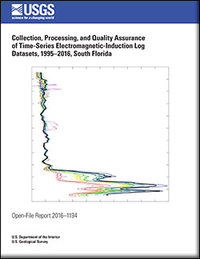Collection, processing, and quality assurance of time-series electromagnetic-induction log datasets, 1995–2016, south Florida
Links
- Document: Report (7.64 MB pdf)
- Data Releases:
- USGS data release - Time Series Electromagnetic Induction Log datasets
- USGS data release - Time Series Electromagnetic Induction-Log Datasets, Including Logs Collected through the 2018 Water Year in South Florida
- USGS data release - Time Series Electromagnetic Induction-Log Datasets, Including Logs Collected through the 2017 Water Year in South Florida
- USGS data release - Time Series Electromagnetic Induction-Log Datasets, Including LogsCollected through the 2016 Water Year in South Florida
- Download citation as: RIS | Dublin Core
Abstract
Time-series electromagnetic-induction log (TSEMIL) datasets are collected from polyvinyl-chloride cased or uncased monitoring wells to evaluate changes in water conductivity over time. TSEMIL datasets consist of a series of individual electromagnetic-induction logs, generally collected at a frequency of once per month or once per year that have been compiled into a dataset by eliminating small uniform offsets in bulk conductivity between logs probably caused by minor variations in calibration. These offsets are removed by selecting a depth at which no changes are apparent from year to year, and by adjusting individual logs to the median of all logs at the selected depth. Generally, the selected depths are within the freshwater saturated part of the aquifer, well below the water table. TSEMIL datasets can be used to monitor changes in water conductivity throughout the full thickness of an aquifer, without the need for long open-interval wells which have, in some instances, allowed vertical water flow within the well bore that has biased water conductivity profiles. The TSEMIL dataset compilation process enhances the ability to identify small differences between logs that were otherwise obscured by the offsets. As a result of TSEMIL dataset compilation, the root mean squared error of the linear regression between bulk conductivity of the electromagnetic-induction log measurements and the chloride concentration of water samples decreased from 17.4 to 1.7 millisiemens per meter in well G–3611 and from 3.7 to 2.2 millisiemens per meter in well G–3609. The primary use of the TSEMIL datasets in south Florida is to detect temporal changes in bulk conductivity associated with saltwater intrusion in the aquifer; however, other commonly observed changes include (1) variations in bulk conductivity near the water table where water saturation of pore spaces might vary and water temperature might be more variable, and (2) dissipation of conductive water in high-porosity rock layers, which might have entered these layers during drilling. Although TSEMIL dataset processing of even a few logs improves evaluations of the differences between the logs that are related to changes in the salinity, about 16 logs are needed to estimate the bulk conductivity within ±2 millisiemens per meter. Unlike many other types of data published by the U.S. Geological Survey, the median of TSEMIL datasets should not be considered final until 16 logs are collected and the median of the dataset is stable.
Suggested Citation
Prinos, S.T., and Valderrama, Robert, 2016, Collection, processing, and quality assurance of time-series electromagnetic-induction log datasets, 1995–2016, south Florida: U.S. Geological Survey Open-File Report 2016–1194, 24 p., https://doi.org/10.3133/ofr20161194.
ISSN: 2331-1258 (online)
Study Area
Table of Contents
- Abstract
- Introduction
- Electromagnetic Induction Logging
- Processing of Time-Series Electromagnetic-Induction Log Datasets
- Presentation of Time-Series Electromagnetic-Induction Log Datasets
- Summary
- References Cited
| Publication type | Report |
|---|---|
| Publication Subtype | USGS Numbered Series |
| Title | Collection, processing, and quality assurance of time-series electromagnetic-induction log datasets, 1995–2016, south Florida |
| Series title | Open-File Report |
| Series number | 2016-1194 |
| DOI | 10.3133/ofr20161194 |
| Publication Date | December 13, 2016 |
| Year Published | 2016 |
| Language | English |
| Publisher | U.S. Geological Survey |
| Publisher location | Reston, VA |
| Contributing office(s) | Caribbean-Florida Water Science Center |
| Description | Report: vii, 24 p.; Data Release |
| Country | United States |
| State | Florida |
| County | Broward County, Glades County, Hendry County, Martin County, Miami-Dade County, Palm Beach County |
| Online Only (Y/N) | Y |


